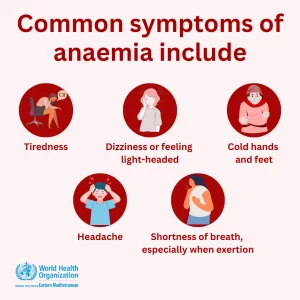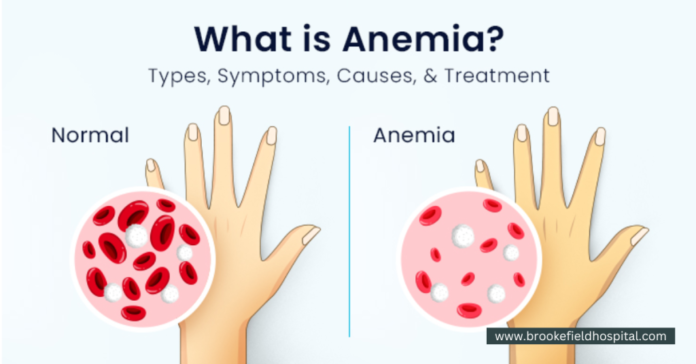Lack of sufficient haemoglobin or healthy red blood cells to deliver oxygen to the body’s tissues is known as anaemia. The molecule called haemoglobin, which is present in red blood cells, transports oxygen from the lungs to every other organ in the body. Breathlessness, weakness, and exhaustion are all possible effects of anaemia.
Anaemia comes in a variety of types. Everyone has a unique reason. Anaemia may be chronic or transient. It could be minor or really serious. Anaemia may indicate a more serious medical condition.

Anaemia treatments may include medical procedures or the use of vitamins. Certain types of anaemia may be avoided by eating a balanced diet.
Symptoms
- Tiredness.
- Weakness.
- Shortness of breath.
- Pale or yellowish skin, which might be more obvious on white skin than on Black or brown skin.
- Irregular heartbeat.
- Dizziness or lightheadedness.
- Chest pain.
- Cold hands and feet.
- Headaches.
Causes
The body produces insufficient red blood cells or haemoglobin.
Haemoglobin and red blood cells are lost by bleeding quicker than they can be regenerated.
Haemoglobin and red blood cells are destroyed by the body.
Prevention
Numerous forms of anaemia are unpreventable. A nutritious diet consists of:
- Iron Dark green leafy vegetables, dried fruit, legumes, beans, iron-fortified cereals, and beef and other meats are among the foods high in iron.
- Folate. Fruits and fruit juices, dark green leafy vegetables, green peas, kidney beans, peanuts, and enriched grain products including bread, cereal, pasta, and rice contain this nutrient and its synthetic version, folic acid.
- vitamin B-12. Meat, dairy products, fortified cereals, and soy products are among the foods high in vitamin B-12.
- Citrus fruits and their juices, peppers, broccoli, tomatoes, melons, and strawberries are foods high in vitamin C. They aid in the body’s iron absorption as well.




























